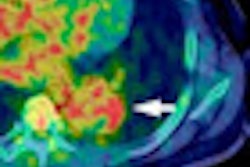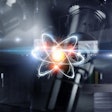Using PET to fine-tune radiation therapy (RT) to take into account which portions of a cancer patient's tumor grow the most rapidly may improve cancer control while subjecting the patient to lower radiation doses, Dutch researchers suggested at the European Lung Cancer Conference in Geneva.
Researchers from the Netherlands Cancer Institute - Antoni van Leeuwenhoek Hospital in Amsterdam conducted investigations to determine if some areas of a tumor might not need irradiation, thereby decreasing the overall radiation dose and minimizing damage while achieving the same therapeutic effect.
After using FDG-PET to measure the glucose metabolism of tumors and identify dark or "cold" spots, they sought to identify whether the cold spots were either dead areas or areas where the FDG isotope injection did not reach.
Principal investigator Christian Siedschlag, Ph.D., of the Netherlands Cancer Institute's radiotherapy department reported that based on preliminary results, the cold spots consisted of dead tumor cells. In seven of 61 patients, cold spots were identified, of which five were identified as dead cells.
Siedschlag said that by decreasing radiation doses given to the cold spots, it might be possible to increase the dose to the rest of the tumor while keeping normal tissue dose constant. This could lead to fewer and less-severe toxicities with an identical therapeutic result.
Related Reading
Split-course RT aids advanced lung cancer patients, March 1, 2010
FDG-PET predicts radiation-induced lung toxicity, July 1, 2009
Radiation therapy for lung cancer patients may affect normal lung tissue, October 27, 2000
Copyright © 2010 AuntMinnie.com




















